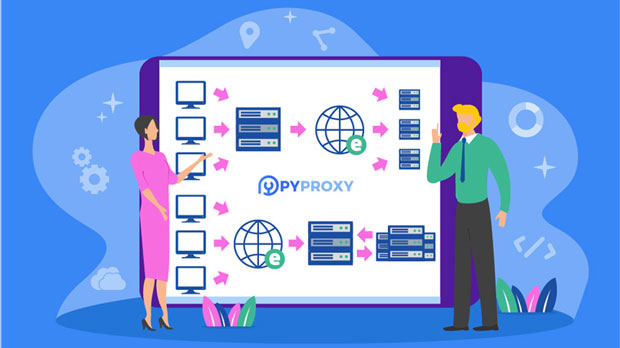When it comes to proxy services, particularly those that facilitate fast and efficient IP switching across multiple regions, PYPROXY and netnut are two popular options. Both services claim to offer quick and reliable IP switching, but how do they perform when it comes to speed in different regions? In this article, we will dive into a detailed comparison of pyproxy and netnut, focusing specifically on their performance in multi-region IP switching. We will analyze their speeds, the technology behind them, and their suitability for various use cases, helping you make an informed decision based on your needs. Understanding the Importance of Speed in Multi-Region IP SwitchingWhen managing internet traffic or engaging in web scraping, data collection, or any other activity requiring multiple IP addresses across different regions, speed becomes crucial. Slow IP switching can lead to delays in operations, poor performance, and in some cases, blocked connections. Both pyproxy and netnut promise to address these issues, but each service does so with its own approach to speed, infrastructure, and reliability.pyproxy: A High-Speed Network Built on Real Residential IPspyproxy is a proxy service that operates on a network of real residential IPs, which gives it an edge when it comes to reliability and authenticity. The company’s infrastructure is designed to provide fast IP switching by leveraging a distributed network of nodes spread across multiple regions. This allows pyproxy to offer clients high-speed IP switches in many global locations.pyproxy’s residential IPs are obtained from ISPs directly, which helps avoid detection by websites and services that might flag proxy traffic. As a result, users experience minimal latency when switching between different regions, making it a suitable option for tasks that demand both speed and security. Moreover, pyproxy’s architecture is optimized for low-latency connections. It uses a peer-to-peer network combined with local data centers, ensuring that users can quickly switch IPs across multiple regions without significant delays.netnut: A Reliable Proxy Service with a Focus on Speednetnut, on the other hand, is known for its fast, cloud-based proxy service. While it doesn’t rely on residential IPs like pyproxy, it utilizes a mix of private and public proxies to provide users with an efficient means of switching IPs quickly. netnut has developed a sophisticated algorithm to ensure rapid IP changes, which is particularly beneficial for use cases that require high-frequency IP switching.In terms of infrastructure, netnut operates a network of high-performance proxy servers distributed in key locations around the world. The company’s technology is designed to minimize latency during IP switching, making it ideal for applications like web scraping, data mining, and other internet operations that need fast connections.netnut focuses on providing a wide array of IP addresses from multiple regions, ensuring that users can quickly access the geographic location they need without a noticeable lag. However, while netnut offers excellent speeds in certain use cases, its reliance on proxy servers rather than real residential IPs can sometimes result in lower authenticity or higher detection rates by websites.Speed Comparison: Which Service Provides Faster Multi-Region IP Switching?In a head-to-head speed comparison, the performance of pyproxy and netnut largely depends on the specific use case, network setup, and regional proximity to proxy servers. However, there are general trends that can be observed:1. pyproxy: Since pyproxy uses residential IPs from ISPs, it can provide more reliable and faster connections in certain regions, especially when high authenticity and low detection are required. The network design prioritizes low-latency switching, making it faster for tasks requiring quick, seamless changes between regions.2. netnut: While netnut’s infrastructure is cloud-based and optimized for speed, its reliance on public and private proxies means it can sometimes face higher detection rates or issues with IP authenticity. However, for non-sensitive tasks or situations where speed is more critical than stealth, netnut can offer extremely fast switching, particularly in regions with better server coverage.Latency: A Critical Factor in Multi-Region IP SwitchingLatency is a critical factor to consider when comparing proxy services. High latency can severely impact user experience, particularly in tasks like web scraping, competitive research, and real-time data collection. Here’s how the two services fare in terms of latency:- pyproxy: Due to its distributed architecture of residential IPs, pyproxy typically enjoys lower latency, especially when switching between regions that are geographically closer to its peer-to-peer network. This is a major advantage for users who need real-time IP changes without experiencing noticeable delays.- netnut: Although netnut has a solid network of cloud servers, latency can vary depending on the proximity of the server to the user’s location. In regions with fewer proxy servers, users may experience slightly higher latency when switching IPs compared to pyproxy. However, netnut compensates for this with optimized routing algorithms that minimize delays wherever possible.Scalability: Adapting to Growing NeedsAnother important factor in multi-region IP switching is scalability. As your needs grow—whether you're expanding to new regions or requiring faster IP switches—you’ll want a service that can scale effortlessly.- pyproxy: pyproxy’s network of residential IPs is vast and growing, meaning it can easily scale to meet the demands of users across a variety of regions. The service is designed to handle high volumes of traffic, making it an excellent choice for businesses or individuals with evolving needs.- netnut: netnut also offers scalability through its cloud-based architecture. While it may not have as extensive a network of residential IPs, its server infrastructure can still handle large-scale switching across multiple regions. However, as the network expands, users may experience occasional fluctuations in speed, depending on the location of proxy servers.Security Considerations in Multi-Region IP SwitchingFor many users, security is as important as speed when switching IPs across multiple regions. Both pyproxy and netnut offer different security features designed to minimize risks associated with proxy use.- pyproxy: Because it uses real residential IPs, pyproxy offers a more secure solution for multi-region switching. Websites and services are less likely to detect traffic as coming from a proxy, which reduces the risk of being flagged or blocked.- netnut: While netnut offers encryption and security features, the use of private and public proxies may expose users to a higher risk of detection by websites. However, its cloud-based infrastructure is generally secure and works well for most non-sensitive tasks.Conclusion: Which Service is Faster for Multi-Region IP Switching?In conclusion, both pyproxy and netnut offer robust solutions for multi-region IP switching, with each having its strengths in terms of speed, reliability, and security. - pyproxy excels in providing faster, more authentic IP switching, particularly in regions where real residential IPs are needed for minimal detection and low latency.- netnut, on the other hand, offers faster IP switching in cloud-based environments, though it might face higher detection rates and occasional latency issues in certain regions.Ultimately, your choice between the two will depend on the specific needs of your project, such as the importance of IP authenticity, the regions you’re targeting, and the type of tasks you’re performing. If stealth and speed are paramount, pyproxy is likely the better choice. If you’re looking for a service optimized for high-speed switching in a cloud environment, netnut might be a suitable option.
Oct 27, 2025


































































